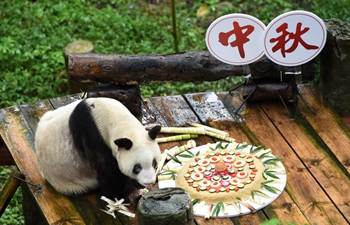SYDNEY, Sept. 26 (Xinhua) -- Brown tree snakes have become one of the world's top invasive species after hitchhiking on planes from Australia, according to a latest Australian-led research.
The devastation of native bird populations on the island of Guam began when the snakes were introduced on the Pacific island during World War II, Associate Professor Bryan Fry from the University of Queensland, whose scientists led the international study, said in a statement on Wednesday.
"The snake hitchhiked on troop carriers from the Australian region and has since driven multiple native bird species into extinction, with only three species now found on the island," he said.
"The snakes' impact was so devastating, it now ranks among the worst pests of all time."
It was initially believed that the brown tree snake's two-toxin venom, while not dangerous to humans but 100 times more toxic to birds than to mammals, was unique to the species, but that was not the case, said Fry.
Any of the cat-eyed snakes belonging to the genus Boiga "would have caused similar devastation" and it was just this particular species that was transported to Guam "by accident," he said.
Cat-eyed snakes evolved in Africa and rapidly spread across the Indian subcontinent, throughout Southeast Asia and to Australia, and the researchers found the snake's toxin type was responsible for its "explosive natural spread."
"For the last 80 years or so, for the brown tree snake at least, this biological advantage has been aided by the introduction of air travel," said Fry, whose team's findings were published in the Journal of Molecular Evolution.
"The United States government is still flying military planes from Guam to Hawaii and the snakes continue to hitchhike."
"They're regularly intercepted in the Hawaii airports, so if these direct flights are allowed to continue, it's only a matter of time until they get to Hawaii and wipe out the birds like they did on Guam," he said.
"Now we know more about the snake's basic biology, we can help in developing a smart approach to preventing and managing this and other invasive species."













